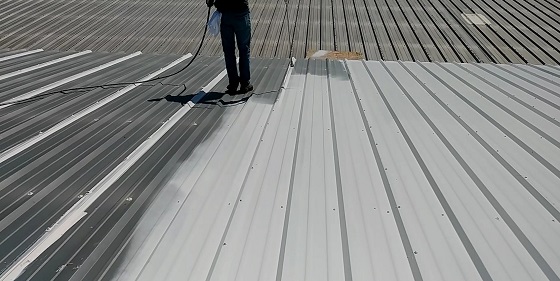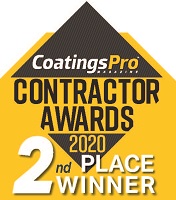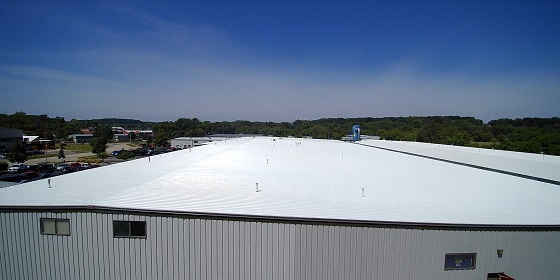Wisconsin Built is an architectural woodworking company located in a farming community in central Wisconsin. They create items, such as custom freestanding fixtures, solid surface countertops, woodworking, and cabinets, for restaurants, commercial interiors, financial institutions, healthcare, and retail. After Gardner Roof Coatings completed a 120,000-square-foot (11,148.4 m2) roofing project for them the previous year, Wisconsin Built knew who to call after they needed help again — this time with leaks.
When Wisconsin Built required the roof recoated on their 140,000-square-foot (13,006.4 m2) building, Bill Tomberlin, project manager at Gardner Roof Coatings, sent them an experienced five-man crew. “The crew was very professional with many years of experience working on metal roof painting and coatings,” said Tomberlin, who is also a certified Level ll Infrared Thermographer and Ground Penetrating Radar operator through Infraspection Institute for Infrared Thermography and US Radar GPS.
Tomberlin has 51 years of experience in the construction/roofing industry, eight of which have been with Gardner Roof Coatings. The company consists of 12 employees and offers residential and commercial exterior projects, in addition to infrared thermography and ground penetrating radar. According to Tomberlin, 90 percent of his projects are cold call visits. But this call was anything but cold.
Prep and Coating
Work on the project began in May 2019 and lasted for two and a half months. Three crew members were responsible for the prep, and two applied the coating. “As with all roof coating projects, preparation is 90 percent of the battle,” noted Tomberlin.
The first step in the process was to tighten and, if needed, replace fasteners. With projects of this nature, often the horizontal seams that are lifted must be stitched. The building had over 8 miles (12.9 km) of seams plus thousands of bolt heads. That’s a lot of work!
Sealing the bolt heads and seams is tedious work requiring team members to spend a great deal of time on their knees. Gardner Roof Coatings devised an innovative solution to this problem. They used 3-foot-long (0.9 m) bulk caulking guns to coat the bolt heads. They also developed a way to rapidly repair the seams by having one crew member using a wand without a spray tip and another behind him with a brush.
JLG manlifts were kept onsite, so the team didn’t have to climb ladders while carrying tools. The substrate itself consisted of steel R-panels that were 36 inches (91.4 cm) wide. Tomberlin recalled that they were in “good condition with very little rust and patches.”
Because this coating project took place in a farming community, there was a large amount of dust from nearby fields. The Gardner crew, therefore, pressure washed the roof’s surface numerous times since the project was such a large one. “We use Generac and Craftsmen, typically 3300 to 4200 psi [22.8–29.0 MPa],” Tomberlin explained. “They are powerful and light and easy to get on the roof.”
Large leaks were repaired just before pressure washing, and the crew was careful not to spray against the laps.

The next step in the process was to coat all fasteners and seams with a thicker viscosity elastomeric from R. M. Lucas. Once cured, the team used two spray rigs, a Graco 833 and a Graco 933, to apply the basecoat, Lucas 6000. After that was completely dry, anywhere from 12 to 24 hours later depending on the weather, the crew then spray applied a topcoat, the Lucas 6500 spray-grade mastic. Both layers were each applied at 16–20 mils (406.4–508.0 microns) wet film thickness (WFT), as per the manufacturer’s specification. The crew used a solvent-borne coating from R. M. Lucas company. To confirm, the coating thicknesses were checked with an electronic mil thickness gage from Extech.
Safety and Training
As expected, a large commercial roofing project comes with safety concerns. “When coating with elastomeric on steel panels, they become extremely slippery,” said Tomberlin. “We do, however, use a different color basecoat and a pure white topcoat, but you can become a little snow blind and step on the wet coating.” Because of this, the workers used a D-ring safety anchor that was bolted near the ridge. Crew members were able to attach the lanyard of their Guardian harness to it, and anchors were left in place for future workers.
In addition, the team wore either N95 masks or VitaFlex hoods, depending on the task. “We also started using a great product called VitaFlex hoods that we found at NACE International’s annual conference in Nashville,” remarked Tomberlin, referring to CORROSION 2019. “Soft-stretch PPE [personal protective equipment] hoods provide effective barrier protection with [the] innovative advantage of comfort,” according to the VitaFlex website. “The soft form-fit securely covers the entire head, face, and neck without restricting peripheral vision, head movement, and [the] wearer’s mobility. Their easy breathability keeps the head cool for extended wear.” When a mask wasn’t required, the crew could wear the fabric hood that the manufacturer notes is safer because it allows fewer harmful substances to be absorbed through the skin.
Additionally, Gardner Roof Coatings provided their own safety and application training. The latter training also included a walk-though by manufacturing reps, who demonstrated proper application of the coatings.
Rain, Dust, and Distractions. Oh My!
No project is without its challenges, but the most frustrating for the Gardner team on this project was by far the weather. That year was one of the wettest on record for the area, and the rain caused the project to run longer than originally anticipated. The crew was able to make the best of it, and they put on rain suits and pressure washed on days when coating could not be performed.
Keeping the roof clean from dirt and sawdust was also a concern. Dust was frequently stirred up by nearby farmers who were active in their fields, given that this project took place in the springtime. And because Wisconsin Built manufactures wood products, and the sawdust it produced was contained in a giant vacuum located near the roof, clouds of sawdust were generated. Those settled on the roof and frequently needed to be cleaned off. “Our pressure washers got a real workout trying to keep the metal roof clean,” Tomberlin said.

And finally, the odor from the solvent-borne elastomeric irritated some of the factory employees. To work around this concern, the team adjusted their spraying times toward evening to avoid working when people were inside the facility.
Success Story
This project was such a success that it won second place in the Commercial Roof category of CoatingsPro Magazine’s 2020 Contractor Awards Program, which is designed to acknowledge the outstanding work of coatings contractors who demonstrate excellence in the field.
Tomberlin had nothing but praise for both his crew and client at Wisconsin Built. “This crew not only knew how to coat roof systems, but they also knew how to do repair work on our spray equipment in the field, which is a great money and time saver,” he said. “Wisconsin Built is the best in the business, not only because of the world-class products they build, but the excellent attitude they portray day in and day out. I wish we could do business with them every year.” That’s success for sure!
